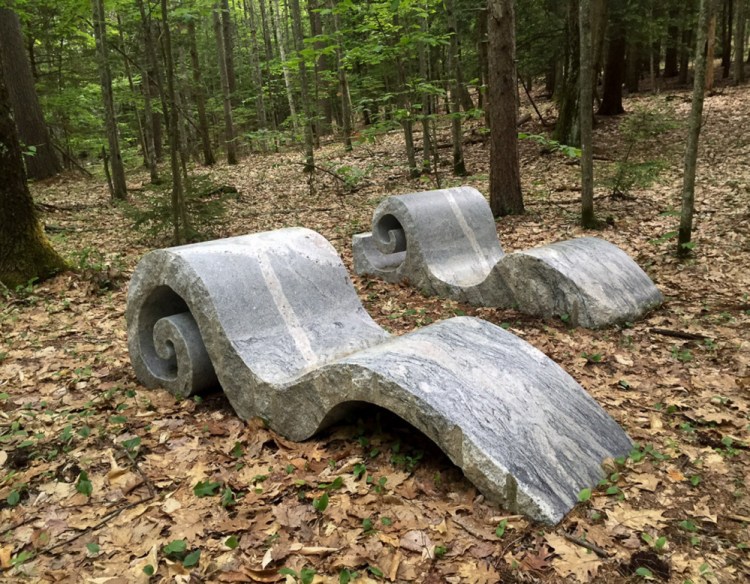June LaCombe has long been the doyenne of Maine sculpture. So much so that in some ways, it’s too easy to think of her as the only sculpture game in town. To be sure, that isn’t true by a long shot: Corey Daniels’ last show, for example, featured a range of ceramics that made for the best sculpture show of the year, and then we have to consider that Courthouse Gallery in Ellsworth, Icon Contemporary in Brunswick and Littlefield Gallery in Winter Harbor, among others, routinely present excellent work.
Just last week, I noted that Jeffrey Ackerman’s sculptures now on view at the Maine Jewish Museum are among the most iconographically ambitious sculptures I have ever seen in the United States. We haven’t even mentioned the Bernard Langlais estate or what’s happening at Colby College, the Portland Museum of Art and the Coastal Maine Botanical Gardens in Boothbay.
Or have we? A couple years ago, for example, I wrote about LaCombe’s show of kinetic sculptures by George Sherwood at the Coastal Maine Botanical Gardens. In addition to showing sculpture at Hawk Ridge Farm (which is both her home and her gallery), LaCombe has for three decades curated major sculpture shows at places like the botanical gardens, Maine Audubon Wells Reserve at Laudholm, the College of the Atlantic and the Chewonki Foundation.
Hawk Ridge Farm in Pownal has long been one of my favorite places to see art in Maine. LaCombe not only has an excellent sense for and a deep knowledge of regional sculpture, but her eye for siting 3D work is practically peerless in New England. No other place in northern New England is as replete with top-tier sculpture presented so well and in such a rich context.

“Janus,” by Gary Haven Smith, granite.
So I was dismayed to learn that this is the last year she will mount public exhibitions at the farm; happily, she’ll continue to consult on art.
LaCombe’s final exhibition there, “Autumn,” features more than 100 works by Gary Haven Smith and the Hamill Collection. It’s open to the public for just one more week, so it’s your last chance to visit her grounds and home gallery. The exhibit ends on Dec. 3, when LaCombe will host an open house to mark the closing of the 2017 season.
Smith’s strongest and most recognizable works are human-scaled granite slabs with cut openings through their centers that reinforce a bilateral but centralized perception of the human body. The openings, often emphasized by gold or metal leaf, hint at both a slender depth and another side. They may be references to the “zips” of American abstract expressionist Barnett Newman – stripes in his reductive paintings that reinforced the idea of the verticalness of the human body and which are mirrored in figurative imagery. (It’s not such a jump from a vertical line to a stick figure.) Both Smith and Newman bring to mind both the reality of our physical bodies and the spiritual sense of the encounter with another human body.

“Fragile Balance,” by Peter Dransfield, bronze, granite.
“Autumn” features many accomplished sculptors with a particular strength in work intended to be shown outside. Ray Carbone’s soaring granite “Voyager,” for example, tilts with a softly sweeping gesture toward the sky, displaying a subtle but zooming bend. It’s a single piece of stone, but the two zip-like cuts give the sense of three strokes reaching upward with a gracefully dovetailing arc. Andreas von Huene’s “Owl Rising” similarly takes an organically swerving bend in the figure’s sculptural gesture to press the sense of movement; the piece shifts dynamically as the stony creature moves to its right, its targeted prey in its sights. Peter Dransfield’s “Fragile Balance” is betrayed by its name: It is a bronze goat perched on a block of stone, but with the muscular intelligence of a creature capable of climbing most anything. Roy Patterson’s bold, dynamic “Ebb Tide” is made of pepper-speckled tapestry granite on an elegant, solid-black stone base that unfurls and recedes as would crashing waves could they shape themselves with mathematical gestures of their own design.
Jordan Smith’s pair of recumbent granite chaises claim a woodsy space on a forested path, part fiddlehead and part crashing wave; the striped granite is inviting to the passing viewer.
Sharon Townshend’s “Time Dance Figure” punctuates the path, a tubular monolithic female figure that seems to be sprouting into a caraytid – a column on a classical building that is shaped like a female form – from the Maine forest. To wholly appreciate the sculpture, the viewer must walk around it. From the front, “Time Dance Figure” appears to be solid cement, but moving around it, you can see it is fully formed, even sensuous, with an extraordinary dress-like seam that articulates the contrapposto buttocks bend of a standing human form.
LaCombe’s inside gallery space is densely and beautifully installed and includes much of my favorite work. Constance Rush, for instance, is represented by a pair of boat-shaped stone works, or possibly more like beans with violin-taut fiddleheads, that are executed with a touch so deft we’d have to look at centuries past to find comparable craftsmanship.
I cannot overstate the urgency of visiting “Autumn.” Excellent sculpture exhibitions are increasingly rare in America. Rarer still are shows of excellent sculpture curated with a sophistication that reaches – or surpasses – the refinement of the strongest work being shown. That’s exactly what LaCombe has given us for years.
Freelance writer Daniel Kany is an art historian who lives in Cumberland. He can be contacted at:
dankany@gmail.com
Send questions/comments to the editors.



Comments are no longer available on this story